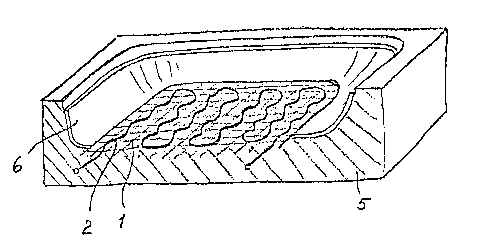Some of the information on this Web page has been provided by external sources. The Government of Canada is not responsible for the accuracy, reliability or currency of the information supplied by external sources. Users wishing to rely upon this information should consult directly with the source of the information. Content provided by external sources is not subject to official languages, privacy and accessibility requirements.
Any discrepancies in the text and image of the Claims and Abstract are due to differing posting times. Text of the Claims and Abstract are posted:
| (12) Patent: | (11) CA 1276963 |
|---|---|
| (21) Application Number: | 1276963 |
| (54) English Title: | FLAT HEATER FOR INCORPORATION IN SEATS OF VEHICLES |
| (54) French Title: | ELEMENT CHAUFFANT PLAN POUR INCORPORATION AU SIEGE D'UN VEHICULE |
| Status: | Expired and beyond the Period of Reversal |
| (51) International Patent Classification (IPC): |
|
|---|---|
| (72) Inventors : |
|
| (73) Owners : |
|
| (71) Applicants : |
|
| (74) Agent: | NORTON ROSE FULBRIGHT CANADA LLP/S.E.N.C.R.L., S.R.L. |
| (74) Associate agent: | |
| (45) Issued: | 1990-11-27 |
| (22) Filed Date: | 1988-02-08 |
| Availability of licence: | N/A |
| Dedicated to the Public: | N/A |
| (25) Language of filing: | English |
| Patent Cooperation Treaty (PCT): | No |
|---|
| (30) Application Priority Data: | ||||||
|---|---|---|---|---|---|---|
|
ABSTRACT
FLAT HEATER FOR INCORPORATION IN SEATS OF VEHICLES
Improved vehicle seats can be made in a process in
which the seat-covering material and a flat heater are
inserted into a negative mold for a vehicle seat and the
mold is filled with in-situ foam because the flat carrier
for the heating conductor of the heater is constituted by
a braided wide-mesh grid made of plastic strings or
plastic yarns, which during the filling of the negative
mold for vehicle seats with in-situ plastic foam are
surrounded by the foam substantially without a change of
the porosity of the plastic foam.
Note: Claims are shown in the official language in which they were submitted.
Note: Descriptions are shown in the official language in which they were submitted.

2024-08-01:As part of the Next Generation Patents (NGP) transition, the Canadian Patents Database (CPD) now contains a more detailed Event History, which replicates the Event Log of our new back-office solution.
Please note that "Inactive:" events refers to events no longer in use in our new back-office solution.
For a clearer understanding of the status of the application/patent presented on this page, the site Disclaimer , as well as the definitions for Patent , Event History , Maintenance Fee and Payment History should be consulted.
| Description | Date |
|---|---|
| Inactive: IPC from MCD | 2006-03-11 |
| Inactive: IPC from MCD | 2006-03-11 |
| Time Limit for Reversal Expired | 2003-11-27 |
| Letter Sent | 2002-11-27 |
| Inactive: Late MF processed | 1999-12-08 |
| Inactive: Late MF processed | 1999-12-08 |
| Inactive: Late MF processed | 1999-12-08 |
| Grant by Issuance | 1990-11-27 |
There is no abandonment history.
| Fee Type | Anniversary Year | Due Date | Paid Date |
|---|---|---|---|
| MF (category 1, 7th anniv.) - small | 1997-11-27 | 1997-11-13 | |
| MF (category 1, 8th anniv.) - small | 1998-11-27 | 1998-11-09 | |
| MF (category 1, 9th anniv.) - small | 1999-11-29 | 1999-12-08 | |
| Reversal of deemed expiry | 1999-11-29 | 1999-12-08 | |
| MF (category 1, 10th anniv.) - small | 2000-11-27 | 2000-09-12 | |
| MF (category 1, 11th anniv.) - small | 2001-11-27 | 2001-11-02 |
Note: Records showing the ownership history in alphabetical order.
| Current Owners on Record |
|---|
| WARME- UND ELEKTROTECHNIK B. RUTHENBERG GMBH |
| Past Owners on Record |
|---|
| BODO RUTHENBERG |
| GUNTER LORENZEN |